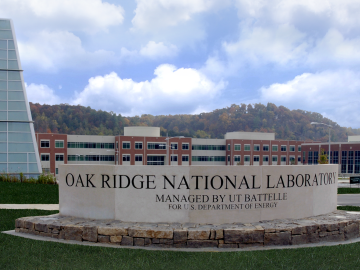Filter News
Area of Research
- (-) Electricity and Smart Grid (3)
- (-) Energy Frontier Research Centers (14)
- (-) Neutron Data Analysis and Visualization (4)
- (-) Nuclear Systems Modeling, Simulation and Validation (3)
- Advanced Manufacturing (34)
- Biological Systems (18)
- Biology and Environment (177)
- Biology and Soft Matter (5)
- Building Technologies (12)
- Chemical and Engineering Materials (4)
- Chemistry and Physics at Interfaces (11)
- Clean Energy (522)
- Climate and Environmental Systems (14)
- Computational Biology (6)
- Computational Chemistry (5)
- Computational Engineering (5)
- Computer Science (19)
- Data (1)
- Earth Sciences (1)
- Energy Sciences (5)
- Fossil Energy (3)
- Fuel Cycle Science and Technology (3)
- Functional Materials for Energy (16)
- Fusion and Fission (54)
- Fusion Energy (17)
- Geographic Information Science and Technology (3)
- Isotope Development and Production (3)
- Isotopes (35)
- Materials (433)
- Materials Characterization (2)
- Materials for Computing (36)
- Materials Synthesis from Atoms to Systems (13)
- Materials Under Extremes (12)
- Mathematics (1)
- National Security (79)
- Neutron Science (190)
- Nuclear Science and Technology (74)
- Nuclear Systems Technology (1)
- Quantum Condensed Matter (4)
- Quantum information Science (9)
- Reactor Technology (1)
- Renewable Energy (4)
- Sensors and Controls (5)
- Supercomputing (311)
- Transportation Systems (11)
News Topics
- Advanced Reactors (1)
- Artificial Intelligence (1)
- Buildings (1)
- Decarbonization (1)
- Energy Storage (1)
- Environment (1)
- Frontier (1)
- Grid (3)
- High-Performance Computing (1)
- Machine Learning (1)
- Materials (1)
- Materials Science (1)
- Microelectronics (1)
- Nanotechnology (1)
- Nuclear Energy (1)
- Simulation (1)
- Sustainable Energy (1)
Media Contacts

Researchers at the Department of Energy’s Oak Ridge National Laboratory are supporting the grid by improving its smallest building blocks: power modules that act as digital switches.

Researchers at the Department of Energy’s Oak Ridge National Laboratory and their technologies have received seven 2022 R&D 100 Awards, plus special recognition for a battery-related green technology product.

A method developed at Oak Ridge National Laboratory to print high-fidelity, passive sensors for energy applications can reduce the cost of monitoring critical power grid assets.

Researchers at Oak Ridge National Laboratory are developing a first-of-a-kind toolkit drawing on video game development software to visualize radiation data.

Nuclear scientists at Oak Ridge National Laboratory have established a Nuclear Quality Assurance-1 program for a software product designed to simulate today’s commercial nuclear reactors – removing a significant barrier for industry adoption of the technology.

Scientists at the Department of Energy’s Oak Ridge National Laboratory induced a two-dimensional material to cannibalize itself for atomic “building blocks” from which stable structures formed. The findings, reported in Nature Communications, provide insights that ...








